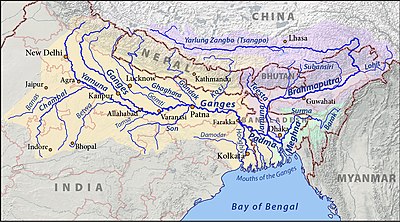Bengal(Bengali:বঙ্গ; romanised:Bôngô) is a cultural and historic region inSouth Asia.It is situated at the apex of the Bay of Bengal. On the north, it is bounded by theHimalayas;on the west by thePlainsof India; on the east byNorth-Eastern India;and on the southeast byMyanmar(Burma). Today most of the region is divided into the Indian state ofWest Bengaland the separate country ofBangladesh,but in some contexts the term "Bengal" includes other areas for historical or cultural reasons. In Indian usage, the term "Bengal" often refers exclusively to West Bengal.
The most important cities of Bangladesh are the capitalDhakaand the historic portChittagong.On the Indian side,Kolkata(Calcutta) is both the state capital and the main port. Major tourist areas include the picturesque hill stationDarjeelingin West Bengal and the beach resort town ofCox's Bazarin Bangladesh. TheSundarbanscover two![]() UNESCO World Heritage Sitesthat span the border with national parks on both sides; the area includes the world's largest mangrove swamp and is home to the Bengal tiger.
UNESCO World Heritage Sitesthat span the border with national parks on both sides; the area includes the world's largest mangrove swamp and is home to the Bengal tiger.
Of course, the region also has other cities and other attractions; seeWest BengalandBangladeshfor those.
Understand
[edit]
Most of Bengal is in the enormous delta area formed by a complex of three rivers.
The Ganges flows roughly west-to-east across much of northern India, and is historically the country's most important river. The Brahmaputra is the greatest river of northeast India, and both it and the Meghna are important in Bangladesh. By the time they reach the sea, the combined rivers (called the Padma in this region) are the world's third largest by volume of water discharged. The Brahmaputra, considered by itself, ranks eighth.
At times political units called "Bengal" extended into nearby areas which were not ethnically or linguistically Bengali. When the British defeated the last Nawab of Bengal and his French allies at theBattle of Plasseyin 1757, they took not only Bengal itself but also the Nawab's other territories, now the states ofBihar,OrissaandJharkhand.Under the British, what is nowAssamwas administered as part of the Bengal Presidency.
When the territory of theBritish Rajwas partitioned in 1947,Hindu-majority West Bengal was given toIndia,whileMuslim-majority East Bengal became part ofPakistan,called East Pakistan. In 1971, East Pakistan broke away from the rest of Pakistan to become the separate country ofBangladesh.
Name
[edit]The English word "Bengal" is anglicised form of the Persian word "Bangala". However, the exact origin of the word is uncertain. Possible origins include the name of a tribe that settled in the area around 1000 BCE and the Austric word for the sun god. There was a mentioning of a seafaring state called "Vanga" inMaurya times.
Culture
[edit]Numerous festivals are celebrated in Bengal, which can be religious, social or national ones. A Bengali proverb saysbaro mase tero parbôn,which literally translates to "thirteen festivals in twelve months".Durga Pujais one of the most celebrated festivals in Bengal. It takes place between September and October, depending on the traditional phases of the Moon.Eid Al Fitr(Bengali:Idulphitôr) andEid Al Adha(Bengali:Idujjoha) are popular among Bengali Muslims.
Talk
[edit]Bengaliis the main language of the region and is widely spoken on both sides of the border. Quite a few people in West Bengal and Tripura also speakHindi.
As anywhere in the subcontinent English is quite widely spoken, but mainly in urban areas and among the educated classes.
